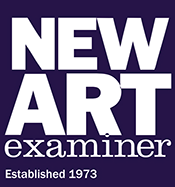
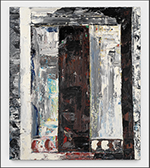

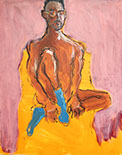
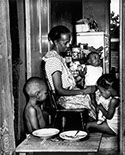
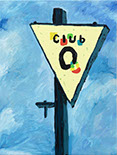
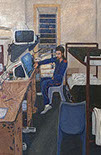
Richard Haines: Paradise Lost
Daniel Cooney Fine Art, New York City, May 4–June 30, 2023
by Paul Moreno
In the second chapter of The Flâneur, Edmund White writes about the Turkish bath at La Mosquée de Paris, which at the start of this millennium still reserved two days each week for male clientele. He notes: “Although many gay men go to the hammam on Sundays (most of them non-Muslims), they understand they are in a house of worship and they look but do not touch—a rule that adds a civilizing distance to their cruising.” This tension of respectful longing, of polite looking, of open fantasy-building that barely dares the transgression of touch, of the observant stranger in a Gallic environ, filled the room at the recent show of paintings by Richard Haines at Daniel Cooney Fine Art.
Richard Haines is best known for his successful career as a fashion illustrator. His work has transcended the boundaries of that industry to draw the attention of a broader audience who love his social media posts of his drawings of handsome fellows in cute clothes often drawn from the perspective of the man-on-the-street in Paris, New York, or on the occasional beach. He is also an educator and man about town. He is in fact a flâneur of sorts. All of this of course informs his occupation as a fine artist. The work does not feel ardently conceptual like it is pushing the boundaries of painting, nor does it feel like it is grasping at the cool to lure art world speculators. Rather this collection of paintings/drawings feel fleeting and poetic, plain and sincere, the kind of paintings that transport the viewer to a time and place when simply being a flâneur is enough.
This particular group of pictures feels like a collection of moments each committed to canvas (or in one case paper) more than a coeval group of pictures developed together with a show in mind. They were mostly painted in 2022-23, and all display Haines’s recognizable hand, but they vary a lot in personality. One corner was occupied by the one work on paper, Quatre Hommes Dans L’eau, and Three Skaters, Manhattan Avenue. Both of these depict a group of young men going about their business, seemingly rendered, at the perfect moment, from observation. In Quatre Hommes…, four lithe, golden-brown, male figures, drawn from angles ranging from full behind to silhouette, form a callipygian display, each loosely outlined in thick black lines, filled with brushy toffee colored paint, the crowns of their heads left bright white reflections of the glaring sun, as the figures move from only ankle deep into the yellow green smears of water below the white streaked turquoise sky. In Three Skaters…, a sort of cadet blue waterfall of a canvas is populated by three boys that we see from an angle of a discreet observer. They’re carrying skateboards. Their bodies are long and thin with ski-like feet and broad hanger-like shoulders from which clothes that look more runway than skatepark hang. There are dark blue squiggles suggesting urban architecture.
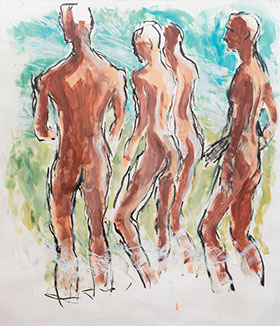
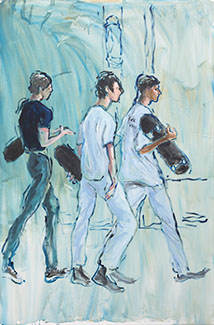
(Left) Quatre Hommes Dans L’eau, 2020. Oil stick, pastel, watercolor on paper, 70 x 63 inches.
(Right) Three Skaters, Manhattan Avenue, 2023. Oil and acrylic on canvas, 60 x 40 inches.
Photos: Daniel Cooney Fine Art.
These two pictures are distinctly different from a trio of paintings on an adjoining wall. I initially thought these were each a double portrait but upon reading the titles, Green Narcissus, Pink Narcissus, and Blue Narcissus, I realized the doubling of the model is the effect of a mirror within the mise-en-scene of the paintings. Each of these small paintings (24 x 18 inches) is composed of a field of a saturated wash of its titular color, a white Eames side chair, a model, and his reflection. The acid green version has the model in high-waisted trousers, shirtless, and his vaguely rendered face is slightly goofy. The salmony pink version has the model leaning one handed into the mirror, one behind his back, as if frozen in a sexy casual minuet. The cornflower blue version takes the unexpected turn of the model being nude but for an eyeless black (leather?) hood. These do not feel spontaneous despite the marks feeling fast and unfussy. They do not have the impromptu energy of the aforementioned bathers or skaters. They feel like a model as still life, posed in the studio, on-the-spot, self-aware. In all of them, the background color seeps through; the gestures of the model’s feet are not concerned with specificity; and the images as a whole feel like a prelude to something we do not see.
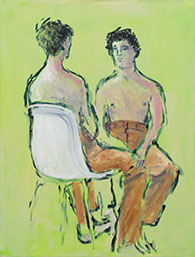
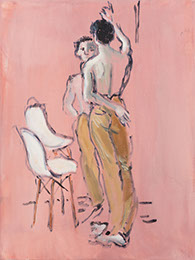
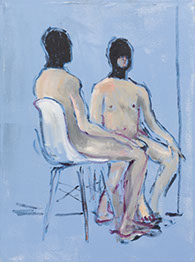
(Left) Green Narcissus, 2023. Oil and acrylic on canvas, 24 x 18 inches. (Center) Pink Narcissus, 2023. Oil and acrylic on canvas, 24 x 18 inches. (Right) Blue Narcissus, 2023. Oil and acrylic on canvas, 24 x 18 inches. Photos: Daniel Cooney Fine Art.
Yet another mood is struck in a painting called Mordechai with Screen and Mirror. This picture possessed the most “finishedness” in the show. The model is simply seated facing the viewer. The outline of his body is less rushed and more finessed. Perhaps most notably, the background is far more considered—no brushy washes here—rather the background is broken into a number of roughly vertical planes depicting, based on the title, a screen and mirror; though these distinctions are left to the viewer to interpret. Perhaps more than in any other painting in the group, here we really see Haines’ love of European romance, particularly, French. The screen appears to depict a diver that calls to mind a Matisse acrobat. The colors and composition suggest an odalisque. The black that covers the model’s shins suggest Schiele. And I am certain I am not the only one who sees a Munchian optical illusion in the painting; but I am not sure that was intentional.
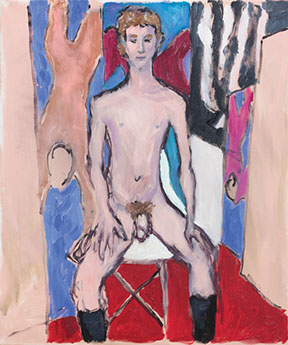
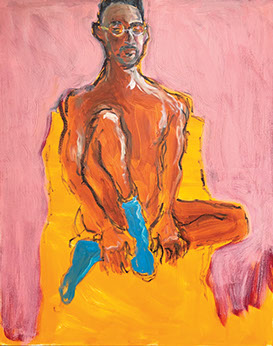
(Left) Mordechai with Screen and Mirror, 2023. Oil and acrylic on canvas, 24 x 20 inches. (Right) Austin with Blue Socks, 2022. Oil and acrylic on canvas, 30 x 24 inches. Photos: Daniel Cooney Fine Art.
The portrait Austin with Blue Socks felt the most modern to me in the sense of painting during the American Century. It is of note that it is the only painting of a person of color. It also steps away from the brevity of mark in the other paintings to give us a more sculpted and detailed countenance. The amaranth-colored background and a rough goldenrod shape that suggests the foreground, as well as some furnishing on which the model sits, form an exciting composition that evokes Clyfford Still. Splashes of white light and the super saturated robin’s egg blue of the socks bring a vitality to the painting.
As I think about this show, recalling and writing about it, I am bathed in the light of a sunset in the western U.S., far from the formerly industrial concrete building that houses the gallery, I am thinking of one last painting, Edo Dives. This picture, so distinct from the rest, depicts a seascape. The blue gray of the water and the gray blue of the sky are beautifully painted in simple strokes. An olive-green mountain climbs up the right side and an anthracite rock juts into the lower left corner where three rough figures contemplate or confront the sea. A bright orange underpainting gives everything a supernatural glow. It is hard to say how this painting connects to the others, but it does. It is easy to see how this show, so tied to unfashionably fashionable styles of paintings feels so fresh. It is because it is done with conviction. Richard Haines makes paintings that you can feel he loves. He is painting in a tradition that includes Cadmus, Bazille, and Hockney. Younger painters such as Louis Fratino and Salman Toor are also part of this lineage. Haines is bringing something unique to the story through, a politeness, a gentle eye, a looking that only looks.
Paul Moreno is an artist, designer and writer working in Brooklyn, New York. He is a founder and organizer of the New York Queer Zine Fair. His work can be found on Instagram @bathedinafterthought. He is the New York City editor of the New Art Examiner.
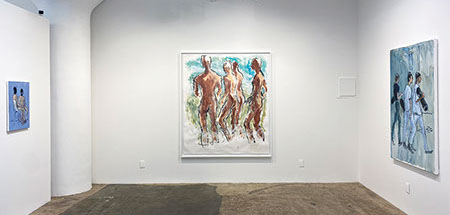
Richard Haines: Paradise Lost, Daniel Cooney Fine Art, installation view. Photo: Daniel Cooney Fine Art.
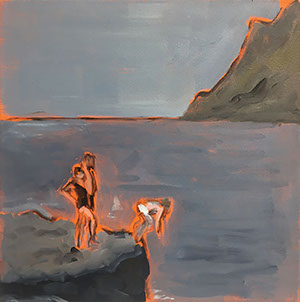
Edo Dives, 2019. Oil and acrylic on canvas 12 x 12 inches. Photo: Daniel Cooney Fine Art.